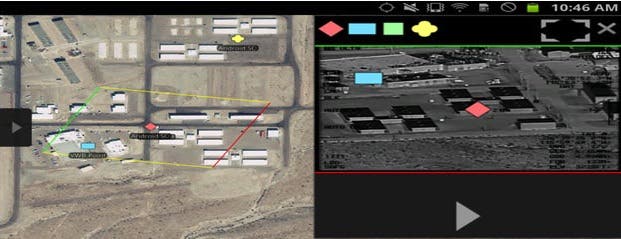
Laura Major of Draper Laboratory holds an Android device with the airstrike app open. (Draper Laboratory)
Yeah, I know – for heaven’s sake is there an app for this too now? It seems so. Draper Laboratory, a not-for-profit research and development lab based in Cambridge, Mass, is currently testing a mobile app that may one day actually see the battlefield and help soldiers order airstrikes simply by using their smartphones. The better communication between the various parties involved in an airstrike ( field soldiers and engineers, desktop technicians surveying information and pilots) could help reduce the amount of friendly or civilian casualties during combat operations.
The Android Terminal Assault Kit or ATAK for short is currently developed to work with Android, and besides calling for airstrikes it will help soldiers by offering them navigation, spatial awareness and a means to control drone systems. The system’s high card is that it will relay real-time information about what’s happening in a combat zone during the delicate and crucial moments before and after an airstrike.
Typically, troops on ground and in the heat of action use GPS receivers and laptops to organize their airstrike. This still involves taking notes of friendlies, actual targets, civilians and other key points, all while calculating the time it takes for the airstrike to hit. The information is relayed to overhead pilots, but occasionally there are transcription, communication or memory errors.
“It’s one thing for a user behind a desk in a climate-controlled office to toggle back and forth between 10 windows, deal with system crashes, and wait 60 seconds for booting up,” Laura Major, who leads Draper’s human-centered engineering work, said in a statement. “It’s another thing to deal with those issues while someone is shooting at you or if you’re jumping out of a plane. That’s where ATAK comes in.”
As troops designate points on ATAK’s map as enemy targets, friendly forces or civilians, Major said, they can say whether the points are artillery, tanks or a church or school, for example. The program will then automatically generate detailed information, such as grid coordinates and elevation, that are crucial for an airstrike. And to make sure troops aren’t about to call in an airstrike on themselves, or on a hostile force that is dangerously close to their position, ATAK will then display that information with hostile forces in red, and friendly forces in blue, including distance and bearing to the closest friendly force.
[NOW READ] Drones capture amazing climbing sights from the Karakoram mountain range [AMAZING PHOTOS]
A prototype has already been tested during military exercises. Results so far have been promising, according to the developers who have used this information to test how efficient and reliable their ATAK app is on the field.
“Operators who used the app during the exercises also indicated that by keeping all of the information in a well-organized, easy to access display, the likelihood of friendly fire accidents, civilian casualties and collateral damage would be significantly reduced,” Draper officials said in a statement.










